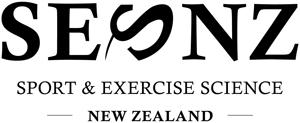2020 SESNZ Annual Conference
Poster Presentations 1. A comparison of a six-second peak power test on a
cycle ergometer with other tests of alactic performance in international rugby union players 1,2
Rogers, T.; 1,3Gill,N.D.; 4Watkins, C.; 1Beaven, C.M.
1
Te Huataki Waiora School of Health, Adams Centre, The University of Waikato, 3116, Tauranga, New Zealand 2 Mackay Cutters Rugby League Club, Mackay, Queensland, Australia 3 New Zealand Rugby Union, 6011, Wellington, New Zealand 4 Sprinz, AUT, Auckland, New Zealand Introduction: The purpose of this study was to compare traditional tests of alactic power, and anthropometric data with the results of a 6-s peak power test on a cycle ergometer (Wattbike Pro, Nottingham Eng.) in international level Rugby players. Thirty-three international level male Rugby Union players participated in the study. Method: Participants completed a 6-s peak power test on a cycle ergometer, 20m sprint and maximum velocity, standing long jump, weighted CMJ (40kg), unweighted CMJ, back squat (3RM), and anthropometric assessments. All tests were completed in two sessions across a single day. Pearson’s correlations were carried out to compare peak power output (PPO) and relative peak power output (W·kg-1) in the 6-s peak power test with the other tests Results: A number of large and very large significant correlations (p≤0.05). Across the group there were significant correlations between PPO and lean mass (r=0.68) PPO and bodyweight (r=0.62), W·kg-1 and 10-m (r=-0.67), 20-m (r=-0.65), W·kg1 and maximum velocity (r=0.63), W·kg-1 and Skinfolds (r=0.56), W·kg-1 and Standing Long Jump (r=0.54), and W·kg1 and CMJ (r=0.53). Various position-specific correlations for the Backs and Forwards were present. Discussion: These results are likely due a number of factors including similarity in exercise duration, energy systems requirements and similarities in muscle groups recruited. Differences between position groups may reflect the unique physical qualities players must possess to meet game demands specific to their position. Take home message: The study suggests that a 6-s cycle ergometer test is associated with sprinting and jumping; and may be an effective substitute test when sprinting or jumping is impossible. Further investigation is warranted to determine if the 6-s cycle test as an effective training tool for sprinting and jumping performance.
2
Faculty of Health and Environmental Science, Sports Performance Research Institute New Zealand (SPRINZ), Auckland University of Technology, Auckland, New Zealand 3 Recreation Centre, Lincoln University, Christchurch, New Zealand 4 Department of Rehabilitation Medicine, Faculty of Medicine, Khon Kaen University, Khon Kaen Thailand Introduction: The aim of this study was to investigate which body composition and physical performance variables characterised players that advanced to professional teams (professionals) and how these variables changed over time compared to those that did not secure professional contracts (i.e. remained amateurs). Methods: Between-player differences in body composition, strength, speed, power and aerobic endurance in 83 male university rugby sport scholarship recipients from 2015-2019 were analysed using Proc Mixed in SAS. Results: When arriving for the first year of the program, forwards that went on to become professional rugby players later in their careers were older (0.4 ± 0.3 yr, mean ± 95% CI), heavier (4.6 ± 2.5 kg) and stronger (range 6.2-16.4%) than forwards that did not gain professional contracts. Professional forwards were also slower at sprinting (range -2.7-2.9%) and had lower Yo-Yo IRT L1 scores (-10.8%) compared to amateur forwards when they first arrived. Backs that went on to become professional players later in their careers were taller (3.5 ± 1.8 cm), heavier (4.6 ± 2.4 kg) and faster over a 20m (-1.9 ± 1.7%) and 30m (-1.7 ± 1.6%) sprint, compared to amateur backs when first arrived on the program. Compared to amateurs, professional players had a smaller increase in body mass (-4.2 ± 2.0%) and greater improvement in sprinting (3.7, 2.8, 2.8% over 10, 20 and 30m) and Yo-Yo IRT L1 performance (14.7 ± 11.0%) over the 3 years training at university. Discussion: Characteristics that are likely to assist rugby players in becoming professionals include being older, heavier, taller and stronger. Compared to amateurs, players that went on to become professionals tended to improve sprint and endurance running performance over their 3 years of training while maintaining skinfold levels. Take home message: Physical prowess is important for potential professional rugby players.
3. Monitoring heart rate, heart rate variability, and
subsequent performance in team-sport athletes receiving hypoxic or normoxic repeated sprint training 2. Differences in body composition and performance
characteristics of male rugby players that went on to become professionals, compared to players that remained amateur 1,2
Hamlin, M.J.; 3Deuchrass, Manimmanakorn, N.
R.W.;
1
Elliot,
C.E.;
4 1
Department of Tourism, Sport and Society, Lincoln University, Christchurch, New Zealand
JSES | https://doi.org/10.36905/jses.2020.03.01
1
Hamlin, M.; 2Lizamore, C.; 2Olsen, P; 2Marshall, H.
1
Lincoln University Ara Institute of Canterbury
2
Introduction: Repeated sprint training in hypoxia is a popular training regime, but careful monitoring is needed to avoid overtraining1. This study aimed to determine whether heart rate variability (HRV) measures taken in the training period are associated with post-training running
36





